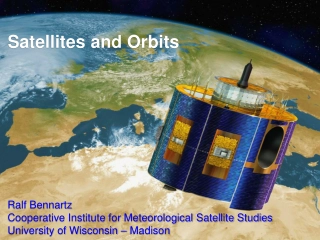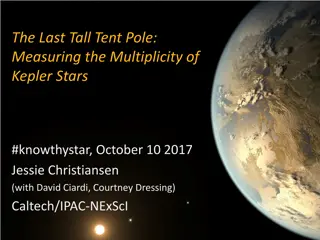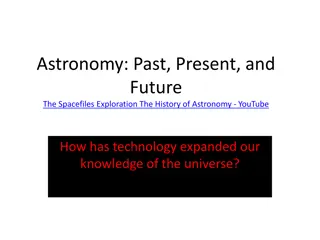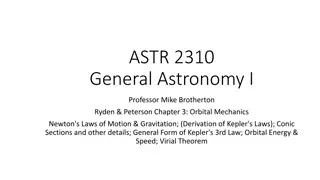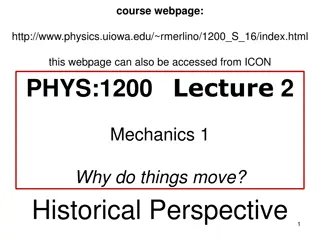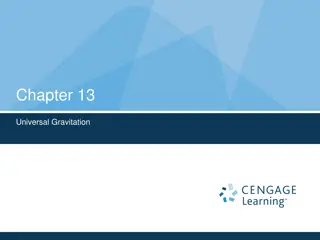Satellites and Orbits
The realm of satellites and orbits, covering topics such as Kepler's Laws, meteorological satellite orbits, the history of satellite remote sensing, and different types of orbits including geostationary and sun-synchronous orbits. Explore the significance of inclination angles, orbital speeds, and d
6 views • 22 slides
Orbital Mechanics: Kepler's Laws, Center of Mass, and Equation of Motion
Exploring the fundamental concepts in orbital mechanics including Kepler's Laws, center of mass calculations, and equations of motion for celestial bodies. Topics covered include the laws of planetary motion, center of mass reference frame, and the concept of reduced mass in celestial mechanics.
5 views • 15 slides
Historical Development of Astronomy in Grade 7 Natural Sciences
Explore the historical development of astronomy with renowned figures like Nicolaus Copernicus, Galileo Galilei, and Johannes Kepler. Discover key advancements in our understanding of the solar system and beyond, including the heliocentric model, telescopic observations, and planetary movement laws.
4 views • 10 slides
Unveiling the Impact of Stellar Multiplicity on Exoplanet Detection
Exploring the effects of stellar multiplicity on exoplanet detection, this research highlights the challenges in accurately measuring Earth-sized planets and proposes high-resolution imaging as a solution. By conducting a survey of Kepler non-host stars, significant insights have been gained, sugges
3 views • 9 slides
Evolution of Astronomy: From Ancient Civilizations to Modern Discoveries
Explore the history of astronomy from ancient Egyptian beliefs in Ra to the groundbreaking theories of Copernicus and Galileo. Witness how technology has revolutionized our understanding of the universe, leading to discoveries such as the heliocentric model and Kepler's laws of planetary motion.
4 views • 25 slides
Orbital Dynamics: Kepler's Laws and Newtonian Gravity
Delve into the fascinating world of orbital dynamics as we explore Kepler's Laws and Newtonian Gravity. From understanding the elliptical orbits of planets around the Sun to uncovering the role of gravity in shaping celestial motion, this journey will illuminate the fundamental principles governing
4 views • 18 slides
Empirical Successes of Newton's Theory of Gravity
Newton's theory of gravity has been empirically validated through observations such as the uniform rate of falling bodies, explanation of Kepler's laws of planetary motion, discovery of new planets, influence on tides, and more. These findings illustrate the depth of understanding achieved by Newton
3 views • 4 slides
Planet Nine: Orbits, Mass, and Kepler's Law
Astronomers speculate about Planet Nine, a massive body in the distant Solar System. Calculations are made about its orbit period, potential interactions with a black hole, and changes in period if it were more massive than the Sun. Utilizing Newton's version of Kepler's Law, astronomers delve into
3 views • 7 slides
The Moon: A Celestial Neighbor
The moon, Earth's closest celestial neighbor, orbits the Earth following Kepler's laws. With a distance of about 240,000 miles and a linear diameter of 2163 miles, the moon's mass is about 1/81 times that of Earth. Learn about the lunar orbit, nodes, and its relationship with synodic and sidereal mo
2 views • 11 slides
Johannes Kepler and His Revolutionary Laws of Planetary Motion
Johannes Kepler, a pivotal figure in the history of astronomy, made groundbreaking discoveries by overturning the geocentric model of the universe. By formulating his three laws of planetary motion, Kepler paved the way for scientific advancements and paved the path for Isaac Newton's law of gravity
2 views • 12 slides
Orbital Dynamics: From Newton's Laws to Kepler's Laws
Exploring the fascinating realm of orbital dynamics, this content delves into the application of Newton's laws to explain Kepler's laws and the intricacies of orbital mechanics. Deriving Kepler's laws from Newton's law of gravitation involves advanced mathematics, while also emphasizing the signific
2 views • 25 slides
Newton's Law of Gravitation and Kepler's Laws of Planetary Motion
Explore the gravitational constant, force of attraction between objects, and equations for calculating gravitational force and centripetal force. Delve into Kepler's laws describing planetary orbits. Uncover the relationship between periods and distances of planets from the sun.
3 views • 9 slides
Kepler's Third Law and Gravitational Work
Kepler's third law relates the orbital period of a planet to its distance from the Sun. In this scenario, we calculate the work required to lift an astronaut from Earth to the ISS and remove them from Earth's gravitational field. We also determine the initial speed needed to project the astronaut fr
1 views • 14 slides
The Scientific Revolution: Advancements in Understanding the Natural World
The Scientific Revolution of the 17th and 18th centuries brought significant changes to European thought, with the development of new scientific methods and institutions like the Royal Society in London. Prominent figures such as Galileo Galilei, Johannes Kepler, and Isaac Newton played crucial role
2 views • 8 slides
Evolution of Earth's Position in Space Over Millennia
Before the 1500s, the geocentric model placed Earth at the center of the universe, which was later challenged by Copernicus with a heliocentric model. Kepler's laws further refined our understanding, particularly the first law focusing on planetary motion in elliptical orbits. This experiment demons
1 views • 19 slides
Evolution of Scientific Thought: From Aristotle to Newton
Explore the historical perspectives of scientific giants like Aristotle, Galileo, Tycho Brahe, Kepler, and Isaac Newton, as they revolutionized our understanding of motion and the universe. Witness the shift from ancient beliefs to modern scientific principles, culminating in Newton's groundbreaking
1 views • 23 slides
Kepler's Laws of Planetary Motion
Explore the fundamental laws discovered by Johannes Kepler in his study of planetary motion. Learn how these laws revolutionized our understanding of the solar system, from the elliptical orbits to the equal area law. Discover the key concepts of focus, eccentricity, aphelion, and perihelion, sheddi
0 views • 21 slides
Universal Gravitation and Planetary Motion
Explore the principles of Newton's Law of Universal Gravitation and Kepler's Laws of Planetary Motion. Delve into the concept of gravitational attraction between celestial bodies and the validation of these laws through the conservation of angular momentum. Learn about the measurement of the gravita
7 views • 20 slides
Orbits and Kepler's Laws in Astronomy
Orbits and Kepler's Laws play a crucial role in understanding the movement of planets, moons, comets, and binary stars in our universe. Kepler's laws describe the elliptical orbits of planets around the Sun, the equal area law, and the relationship between a planet's distance from the Sun and its or
4 views • 29 slides
Chaos Theory: A Journey from Kepler to Fractals
Delve into the fascinating world of chaos theory, tracing its evolution from the seminal works of Kepler and Newton to the complexities of Poincare's findings and modern chaos concepts. Discover the dynamics of chaotic systems like the simple pendulum and understand the implications of sensitive dep
2 views • 20 slides
Influential Scientists in History: Newton, Hawking, Einstein, and Kepler
Explore the remarkable contributions of influential scientists from different eras - Sir Isaac Newton, Stephen Hawking, Albert Einstein, and Johannes Kepler. Learn about Newton's laws of motion, Einstein's theory of relativity, Hawking's work on black holes, and Kepler's laws of planetary motion.
7 views • 10 slides
Satellite System Design Considerations and Applications
Satellite system design involves various technical considerations such as optimal modulation, coding schemes, and service types. Positioning satellites in orbit faces challenges like frequency and orbit selection. Satellite limitations include high initial investments and spectrum crowding. However,
6 views • 32 slides
The Scientific Revolution: From Medieval Roots to Modern Discoveries
Developments in the Middle Ages and the Renaissance laid the foundation for the seventeenth-century Scientific Revolution. This transformation was influenced by advancements in ancient knowledge, close observation of nature, mathematical reasoning, and technological innovations. Figures like Coperni
3 views • 21 slides
Experimental Testing of Physical Theories by Caitlin Mace - HPS 2103 Spring 2022
A detailed examination of the relationship between experimental testing and theoretical complexity in physics, exploring the limitations and implications of conducting experiments within the framework of complex theories. The content delves into the challenges faced by physicists in distinguishing b
1 views • 11 slides
Enlightenment and Revolution 1550-1789 Chapter 22 Overview
This chapter provides a comprehensive overview of the Enlightenment and Revolution era between 1550-1789. It covers key concepts including the Scientific Revolution, Enlightenment thinkers such as Galileo Galilei, Isaac Newton, John Locke, Voltaire, and more. The vocabulary section introduces terms
0 views • 32 slides
The Origin and Evolution of the Universe
Debate in medieval philosophy over the universe's past, Kepler's finite universe theory, Newton's motion principles, and Poe's "Primordial Particle" concept. The Big Bang theory by Georges Lemaître and Edwin Hubble, with Friedmann's dynamic cosmological model. Also covers the Steady State theory an
2 views • 9 slides
Evolution of the Heliocentric Model: Science vs. Church
The Church historically backed the Geocentric Model, placing Earth at the center of the universe based on biblical interpretations. However, trailblazing astronomers like Copernicus, Brahe, and Kepler challenged this notion by proposing the Heliocentric Model with the Sun at the center. This shift l
5 views • 18 slides
Workflow Management and Systematic Organization
A workflow comprises orchestrated business activities organized into processes that transform materials, provide services, or process information. Learn about different types of workflows, examples, the Kepler system, CONNJUR Workflow Builder, provenance types, and the importance of reproducibility
0 views • 17 slides
Reach for the Stars 2025: Astronomy and Stellar Evolution Overview
Explore the world of Astronomy and Reach for the Stars with a detailed overview of topics like Stellar Evolution, Stellar Classification, and Kepler's Law. Discover the scientific principles associated with observatories and enhance your knowledge of late stage stellar evolution. Participants can te
1 views • 7 slides
Exploring 17th-Century Physics: Light, Cosmology, and Optics
Delve into the fundamental problems faced by 17th-century physicists, including the nature of light, cosmological structure, and theories of motion and matter. Discover insights from Keplerian optics, Alhazen's eye studies, and the evolution of optics post-Kepler. Explore the shift towards experimen
3 views • 20 slides
Revolutionizing Views: Astronomy & Science Advancements
Discover how astronomers reshaped perceptions of the universe through the heliocentric model, the scientific method, Newton's gravitational theory linking physics and astronomy, and advancements in chemistry and medicine during the Scientific Revolution. Explore key figures like Copernicus, Kepler,
3 views • 26 slides
Newton's Laws of Motion and Orbital Mechanics
Derivation of Kepler's Laws, orbital dynamics, angular momentum, orbital energetics, and applications of Kepler's third law with a focus on the mass of the sun. Explore the relationships between orbital energy, speed, and Kepler's laws. Understand the concepts of angular momentum and the conservatio
1 views • 25 slides
Orbital Dynamics & Kepler's Laws: Explained Through Newton's Theory
Orbital dynamics and Kepler's laws are elucidated using Newton's theory of gravitation and motion, revealing the intricacies of orbital mechanics. Explore the derivation of Kepler's laws, orbital energy, speed, and more with insightful details on conic sections. Angular momentum, orbital energetics,
2 views • 6 slides
Orbital Mechanics & Kepler's Laws: Understanding Orbital Dynamics
In this study of orbital mechanics, delve into Newton's laws of motion and gravitation to explore the derivation of Kepler's laws, along with insights on conic sections, Kepler's 3rd law, orbital energy, and more. Discover how angular momentum and orbital energetics play pivotal roles in determining
3 views • 48 slides
Kepler's Astounding Haul of Multiple-Planet Systems Overview
Explore Kepler's remarkable discovery of 1,235 planetary candidates, including 827 singles and 408 multiples in 170 planetary systems. Discover the significance of flatter systems, the prevalence of smaller planets, the rarity of Hot Jupiters in flat systems, and the insights gained from gravitation
2 views • 7 slides
Exploring the Origins of the Universe
Discover the fascinating debate in Medieval philosophy surrounding the universe's past and Johannes Kepler's argument for a finite universe. Learn about the Big Bang theory proposed by Georges Lemaitre and the groundbreaking discoveries by Edwin Hubble. Delve into other cosmological theories like th
5 views • 9 slides
Satellite Communication Overview and Components
Explore the world of satellite communication, from its historical milestones to classification and functional requirements. Learn about satellites, their orbits, Kepler's laws, and basic components. Understand the significance of transmitting and receiving antennas in satellite communication systems
6 views • 23 slides
Planetary Motion in History and Kepler's Laws Explained
Explore the historical significance of planetary motion from Ptolemy to Kepler, followed by an explanation of Kepler's laws including the Law of Ellipses, Law of Areas, and Law of Periods. Understand how these laws revolutionized our understanding of celestial bodies in the universe.
1 views • 11 slides
Laws of Planetary Motion by Johannes Kepler and Tycho Brahe
Explore Johannes Kepler and Tycho Brahe's 3 laws of planetary motion, including ellipses, equal area in equal time, and deriving period radius. Delve into calculating geostationary orbit radius and determining Mars's year based on its distance from the sun.
1 views • 5 slides
Understanding Kepler's Laws and Gravity in Astronomy
Explore the significance of Kepler's Laws, the impact of gravity on astronomical objects, and the Copernican system's revolutionary approach to celestial motion. Delve into the differences between geocentric and heliocentric theories, and grasp the essence of Ptolemy's versus Copernicus's perspectiv
0 views • 25 slides
